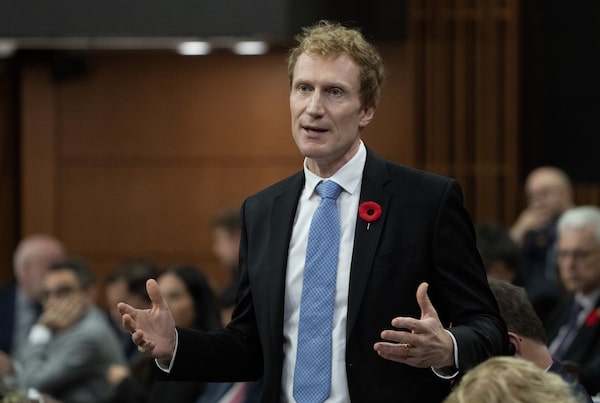
Immigration, Refugees and Citizenship Minister Marc Miller rises during Question Period, in Ottawa, on Oct. 31. New targets tabled in Parliament show the government plans to level out the number of new permanent residents to Canada in 2026, forecasting an end to record-breaking year-over-year immigration.Adrian Wyld/The Canadian Press
Prime Minister Justin Trudeau’s government this week took a baby step toward recognizing its immigration policy needs some fixing by halting future increases in the number of permanent newcomers the country intends to accept.
Still, Immigration Minister Marc Miller seemed to suggest that ”stabilizing” the number of new permanent residents at 500,000 constitutes a concession on his government’s part. Yet, under Mr. Miller’s plan, Canada is still on track to accept more new permanent residents next year (485,000) than it will absorb this year (465,000), or than it did last year (more than 437,000) before the number tops out at 500,000 in both 2025 and 2026.
Even more new permanent residents means even more pressure on the country’s housing market, infrastructure and health care system, even if the minister insists many of these newcomers will fill jobs building houses or caring for hospital patients.
The absence in Mr. Miller’s plan of any measures to rein in the number of temporary foreign workers and international students entering the country means Canada’s acute housing shortage is likely to get much worse before it gets better.
Perhaps the Liberals could hardly be expected to reverse course on immigration at the same time as they are being pummelled by critics across the spectrum for suspending the federal carbon tax on home-heating oil, in a crass bid to save their political skin in Atlantic Canada. The political optics of defenestrating yet another core Liberal policy would reinforce the impression of a government that has grown long in the tooth and is out of new ideas.
The best Mr. Miller has to offer for now is a plan to try to get more new permanent residents to settle in small towns, francophone communities outside Quebec, and in the North. Mr. Miller is hardly the first immigration minister to articulate this objective. But even if successful, such a plan would do little to alleviate the stresses that high immigration is causing in Canada’s biggest cities. Only a small proportion of newcomers will ever seek to settle outside a major urban centre. And even if they initially do so, chances are they will move to a big city before long.
Mr. Miller’s goal of increasing the target for francophone newcomers outside Quebec to 6 per cent of all permanent residents in 2024, 7 per cent in 2025 and 8 per cent in 2026, aims to keep minority French-speaking voters happy. Population decline is a fact of life in most French-speaking communities outside Quebec. Their very survival is at stake.
Between 2016 and 2021, however, francophones accounted for barely 2.2 per cent of the total number of permanent residents Canada accepted annually during that period. Ottawa met its previous goal of 4.4 per cent francophone immigration, first set in 2000, for the first time last year. And that was only after holding special “draws” reserved for francophones, overriding the points system Canada has used for almost six decades to rank permanent-resident applicants.
Ottawa’s bid to double francophone immigration levels outside Quebec comes as that province seeks to ensure most of its newcomers can speak French before they arrive. Mr. Miller’s objective of attracting more francophone immigrants outside Quebec will create even more friction between Premier François Legault and Mr. Trudeau on the immigration file.
Mr. Legault’s government this week announced its own immigration targets for 2024 and 2025, capping the official number at 50,000 each year. But that figure does not include about 6,500 foreign students under a provincial program that fast-tracks francophone-university graduates for permanent residency status.
Quebec also intends to clear a backlog of about 6,000 business applicants, bringing the total number of newcomers the province accepts next year to around 63,000 people. Still, that amounts to only 13 per cent of the 485,000 total number of new permanent residents Ottawa intends to accept in 2024, or well below Quebec’s 22 per cent share of the Canadian population.
Mr. Legault has called on Ottawa to cede more control to Quebec over temporary immigration, over which the province has only limited authority. Most of the 476,000 temporary residents currently in the province do not speak French, despite being employed in service-industry jobs. That is making many francophones uneasy, and Ottawa cannot ignore them for long.
With the Parti Québécois now within striking distance of Mr. Legault’s Coalition Avenir Québec – a Léger poll this week showed the CAQ is rapidly losing support, with only a four-percentage-point lead over the PQ – the Premier is unlikely to ease his hardline stance on immigration any time soon. The PQ advocates cutting immigration to a mere 35,000 newcomers a year.
Someone in Ottawa needs to take note: The two solitudes of Canadian immigration policy cannot co-exist for much longer before something has to give.